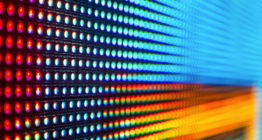Industry Insights: Experts show us the trends in display technology

Subscribe to NCS for the latest news, project case studies and product announcements in broadcast technology, creative design and engineering delivered to your inbox.
We recently gathered a panel of broadcast display technology experts to discuss their industry.
In this part of our Industry Insights panel, our group of integrators and manufacturers tell us about the latest trends in the display technology market.
How has the display market changed in the past year?
“Monitor pricing seems to keep falling from some of the vendors while others seem overpriced for the same tech. Always been that way,” said Jim Landy of AV Design Services.
“Over the last few years, there’s been an increase in the availability of powerful display technology at accessible prices. It’s like a candy store with so much variety and so many manufacturers that you really can deliver against any creative brief. This increasing range of technology offers great opportunities for innovative design. This is increasingly permeating into the minds of designers and they’re becoming more creative and ambitious, realizing that they’re no longer limited to just a square box, flat display,” said Mark Holdway, director at Anna Valley.
“Technology has improved tremendously and fine pixel-pitch LED panels are more affordable. All stations prefer LED technology over LCD, projection, or lightboxes. They provide more versatility, ease of maintenance and color consistency over all other options, rendering LED the new standard,” said Emelia Pitlick, marketing director at Neoti.
“There continue to be new entrants into the display market and product evolution. People are getting more creative about using the technology and transforming their storytelling. People are going beyond just replacing walls and adding innovative solutions including floors, transparent displays, non-standard implementations like spheres, columns, and even ceiling displays. It’s exciting to see innovative new designs come to life,” noted Kathy Skinski, general manager of broadcast at Planar.
What is the current upgrade cycle for display tech?
“Monitors seem to last about three-plus years. LED has a much longer life cycle. It is being installed in a studio that is typically 55 degrees and run at about 20% brightness You can expect a long lifespan from LED. Monitors run at rated brightness for typically three-plus years. What is more relevant is the stale studio set cycle; seems to be that sets start to look “stale” and that cycle is about four years. This seems to follow the tech curve. New tech refreshes on about a three-year cycle. Remember that consumer usually pushes changes on the commercial side when it comes to tech,” said Landy.
“A typical upgrade cycle might be around five years but the lifespan of much of the technology can be up to ten years, which means that technology can outlive the sets or the programs they were originally designed for. The longevity of this equipment creates a new opportunity for clients to save money and demonstrate their green credentials by repurposing this technology for a second life in a new or upgraded set, which we have done for a number of clients. With this in mind, it is important to consider the maintenance and support of existing installations at the point of purchase as manufacturers may not support older products or even have spare parts available for displays that aren’t actually that old. For this reason, we recommend that customers expand the number of spares they buy up-front, so that they have security of supply and can extend the life of the display if they choose to,” Holdway suggested.
At the local level, Pitlick notes “five to ten years, depending on an individual station’s ratings, market position and viewer count.”
“It all depends on the display and the use but generally, the lifetime of current LED technology offers more than 100,000 hours of continuous operation. What we see more often are customers upgrading because of the innovations in display technology, whether it’s upgrading from LCD to LED to get rid of the bezel or tighter pixel pitch to give the content a visual pop and crispness. It’s an exciting time in the broadcast display market especially because today’s broadcasters are so amazingly innovative and embracing of the visual possibilities available today,” said Skinski.
Any other trends or issues of note in 2020?
“It seems like the multitude of LED companies is beginning to level out. The key to LED is to work with the right integration specialty company. You might think you can work with the right LED company directly, but the chances of them being around in a couple years is slim to none. You could very easily end up with a lot of display tech that you can’t get repaired because those companies are no longer in business, or, more importantly, they never manufactured to begin with. Much better to stay with an experienced display integration specialist that can service what they sell and has vetted all of tech they recommend and the vendors that supply them. Look for the long term and not always the cheapest pricing. Cheap usually means cheaply made,” Landy said.
“The rate of technology development has sped up so much recently that broadcast studio sets that were only commissioned a couple of years ago are already in danger of being outdated and modern studios are under constant pressure to refresh their look and implement the latest tech. Increasing the use of display technology in TV set design can solve this problem, providing both creative freedom and a future-proof solution to studio design, as you can change the entire look by simply changing the content on the displays. In the LED market an increasing range of ever more flexible (literally) and creative shapes are now available and very narrow bezel video walls continue to have a place in studio sports sets in particular. Similarly, the array of video projector options still offer great opportunities for creative applications now that laser light sources offer long, service-free running times and silent operation,” said Holdway.
“The transparent 55-inch is a fan favorite. The election cycle is here and date visualization and AR is gaining traction,” Skinski answered.
Participants
Jim Landy – AV Design Services
Mark Holdway – Anna Valley
Emelia Pitlick – Neoti
Kathy Skinski – Planar
Subscribe to NCS for the latest news, project case studies and product announcements in broadcast technology, creative design and engineering delivered to your inbox.





tags
Anna Valley, AV Design Services, display technology, Emelia Pitlick, jim landy, Kathy Skinski, LED, LED Displays, LED Video Walls, Mark Holdway, Neoti, Planar, studio display, trends, Video Walls
categories
Display Systems, Displays, Featured, Industry Insights, Studio Technology, Video Walls, Voices